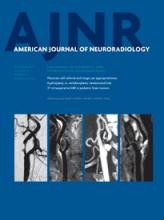Abstract
BACKGROUND AND PURPOSE: During surgery to treat an aneurysm in the anterior communicating artery, injury to the subcallosal artery, a perforator of the anterior communicating artery, may lead to infarction that produces basal forebrain amnesia after surgery. Our purpose was to examine whether 3D MR imaging can detect subcallosal artery infarction in patients with amnesia after surgery for an anterior communicating artery aneurysm.
MATERIALS AND METHODS: We evaluated 3D–T2-weighted MR images obtained a median of 4 months after treatment of anterior communicating artery aneurysm for the presence of infarcted foci in 10 consecutive patients with postoperative amnesia. Because the subcallosal artery and its neighboring perforator, the recurrent artery of Heubner, were considered the most easily affected vessels during that surgery, we focused mainly on 8 regions of the subcallosal artery territory per hemisphere and 5 regions of the recurrent artery of Heubner territory per hemisphere.
RESULTS: All 10 patients had infarcts in the territory of the subcallosal artery (median, 9 regions per patient), and most were bilateral (9 of 10 patients). Five patients had additional infarcted foci in the territory of the recurrent artery of Heubner (median, 1 region per patient), all unilateral. Among the regions perfused by the subcallosal artery, the column of the fornix was involved in all patients; the anterior commissure, in 9; and the paraterminal gyrus, in 8 patients.
CONCLUSIONS: 3D MR imaging revealed subcallosal artery infarction, the distribution of which was mostly bilateral, presumably owing to the unpairedness of that artery, in patients with postoperative amnesia after anterior communicating artery aneurysm repair.
ABBREVIATIONS:
- ACoA
- anterior communicating artery
- IQ
- full-scale intelligence quotient
- MQ
- general memory quotient
- RAH
- recurrent artery of Heubner
- VISTA
- volumetric isotropic turbo spin-echo acquisition
- © 2014 by American Journal of Neuroradiology
Indicates open access to non-subscribers at www.ajnr.org












